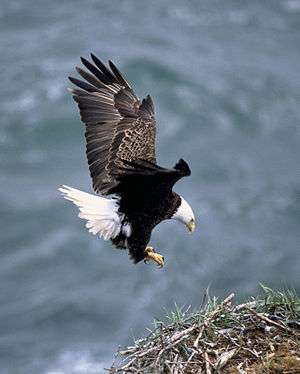Sea eagle
| Sea eagles Temporal range: Late Eocene to present | |
|---|---|
 | |
| Bald eagle (Haliaeetus leucocephalus) | |
| Scientific classification | |
| Kingdom: | Animalia |
| Phylum: | Chordata |
| Class: | Aves |
| Order: | Accipitriformes |
| Family: | Accipitridae |
| Subfamily: | Haliaeetinae |
| Genus: | Haliaeetus Savigny, 1809 |
| Species | |
|
Haliaeetus leucogaster | |
A sea eagle (also called erne or ern, mostly in reference to the white-tailed eagle) is any of the birds of prey in the genus Haliaeetus[1] in the bird of prey family Accipitridae.
Sea eagles vary in size, from Sanford's sea eagle, averaging 2.0–2.7 kg, to the huge Steller's sea eagle, weighing up to 9 kg.[2] At up to 6.9 kg, the white-tailed eagle is the largest eagle in Europe. Bald eagles can weigh up to 7.5 kg, making them the largest eagle native to North America. The white-bellied sea eagle can weigh up to 3.4 kg.[2] Their diets consist mainly of fish and small mammals.
The genus Haliaeetus was introduced in 1809 by the French naturalist Marie Jules César Savigny in his chapter on birds in the Description de l'Égypte.[3][4] The eight living species are:[2]
- White-bellied sea eagle (H. leucogaster)
- Sanford's sea eagle (H. sanfordi)
- African fish eagle (H. vocifer)
- Madagascan fish eagle (H. vociferoides)
- Pallas's fish eagle (H. leucoryphus)
- White-tailed eagle (H. albicilla)
- Bald eagle (H. leucocephalus)
- Steller's sea eagle (H. pelagicus)
Their tails are entirely white in adult Haliaeetus species except Sanford's, white-bellied, and Pallas's. Three species pairs exist: white-tailed and bald eagles, Sanford's and white-bellied sea eagles and the African and Madagascan fish eagles,[5] each of these consists of a white- and a tan-headed species.
Haliaeetus is possibly one of the oldest genera of living birds. A distal left tarsometatarsus (DPC 1652) recovered from early Oligocene deposits of Fayyum, Egypt (Jebel Qatrani Formation, about 33 Mya) is similar in general pattern and some details to that of a modern sea eagle.[6] The genus was present in the middle Miocene (12-16 Mya) with certainty.[7]
Their closest relatives are the fishing eagles in the genus Ichthyophaga, very similar to the tropical Haliaeetus species.[2] The relationships to other genera in the family are less clear; they have long been considered closer to the genus Milvus (kites) than to the true eagles in the genus Aquila on the basis of their morphology and display behaviour,[2][8] more recent genetic evidence agrees with this, but points to them being related to the genus Buteo (buzzards/hawks), as well, a relationship not previously thought close.[5]
The origin of the sea eagles and fishing eagles is probably in the general area of the Bay of Bengal. During the Eocene/Oligocene, as the Indian subcontinent slowly collided with Eurasia, this was a vast expanse of fairly shallow ocean; the initial sea eagle divergence seems to have resulted in the four tropical (and Southern Hemisphere subtropical) species found around the Indian Ocean today. The Central Asian Pallas's sea eagle's relationships to the other taxa is more obscure; it seems closer to the three Holarctic species which evolved later and may be an early offshoot of this northward expansion; it does not have the hefty yellow bill of the northern forms, retaining a smaller, darker beak like the tropical species.[5]
The rate of molecular evolution in Haliaeetus is fairly slow, as is to be expected in long-lived birds which take years to successfully reproduce. In the mtDNA cytochrome b gene, a mutation rate of 0.5–0.7% per million years (if assuming an Early Miocene divergence) or maybe as little as 0.25–0.3% per million years (for a Late Eocene divergence) has been shown.[5]
A 2005 molecular study found that the genus is paraphyletic and subsumes Ichthyophaga, the species diverging into a temperate and tropical group.[9]
Webcams
Nesting pairs of both the bald eagle and white-bellied sea eagle have been subject to live streaming webcam footage.[10][11]
See also
- Brahminy kite, also called red-backed sea eagle
References
- ↑ Etymology: New Latin "sea eagle", from Ancient Greek ἁλιάετος (haliaetos) or ἁλιαίετος (haliaietos, poetic (e.g. Homeric) variant), "sea eagle, osprey" (hali, "at sea" (dative case), + aetos, "eagle"). The two variant Greek forms lie behind the equally correct Latinizations haliaetus (as in Pandion haliaetus) and haliaeetus.
- 1 2 3 4 5 del Hoyo, Elliott & Sargatal 1994.
- ↑ Savigny, Marie Jules César (1809). Description de l'Égypte: Histoire naturelle Volume 1 (in French). Paris: Imprimerie impériale. pp. 68, 85.
- ↑ Mayr, Ernst; Cottrell, G. William, eds. (1979). Check-list of Birds of the World. Volume 1 (2nd ed.). Cambridge, Massachusetts: Museum of Comparative Zoology. p. 299.
- 1 2 3 4 Wink, Heidrich & Fentzloff 1996.
- ↑ Rasmussen, D., Tab, O., Storrs, L., & Simons, E. L. (1987). Fossil Birds from the Oligocene Jebel Qatrani Formation, Fayum Province, Egypt. Smithsonian Contributions to Paleobiology 62: 1-20. PDF Fulltext (file size 8.1 MB)
- ↑ Lambrecht, K. (1933). Handbuch der Palaeornithologie. Gebrüder Bornträger, Berlin.
- ↑ Brown, L. H, & Amadon, D. (1968). Eagles, Hawks and Falcons of the World. Country Life Books, Feltham.
- ↑ LM2005.pdf
- ↑ AFP. "Eagle cam becomes net sensation". Sydney Morning Herald. Retrieved 5 April 2011.
- ↑ "EagleCam". Birds Australia website. Birds Australia. 8 February 2011. Retrieved 5 April 2011.
- Sources
- del Hoyo, J.; Elliott, A.; Sargatal, J., eds. (1994). Handbook of the Birds of the World. 2. Barcelona: Lynx Edicions. ISBN 84-87334-15-6.
- Wink, M.; Heidrich, P.; Fentzloff, C. (1996). "A mtDNA phylogeny of sea eagles (genus Haliaeetus) based on nucleotide sequences of the cytochrome b gene" (PDF). Biochemical Systematics and Ecology. 24 (7–8): 783–791. doi:10.1016/S0305-1978(96)00049-X.